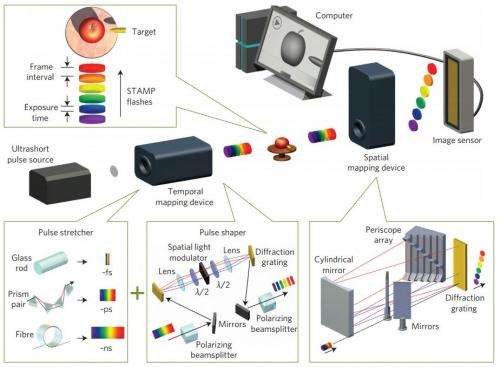August 11, 2014 report
Japanese universities develop new world's fastest camera

(Phys.org) —Researchers working at two universities in Japan have jointly developed what is being described as the world's fastest camera. A photo-device with a frame interval of 4.4 trillion frames per second. In their paper published in the journal Nature Photonics, the team describes how their camera works, its capabilities and the extensive work that went into its creation.
High speed cameras allow researchers and everyday people alike the ability to see things that they wouldn't be able to otherwise, from slowdown of sports play to mechanical processes. Prior to the announcement in Japan, the fastest cameras relied on what's known as a pump-probe process—where light is "pumped" at an object to be photographed, and then "probed" for absorption. The main drawback to such an approach is that it requires repetitive measurements to construct an image. The new camera is motion-based femtophotography, performing single-shot bursts for image acquisition, which means it has no need for repetitive measurements. It works via optical mapping of an object's spatial profile which varies over time. Its abilities make it 1000 times as fast as cameras it supersedes. In addition to the extremely high frame rate, the camera also has a high pixel resolution (450 × 450).
Developed by a joint team of researchers from Keio University and the University of Tokyo, the camera is set to capture images of things and events that until now have not been impossible. With technology the team has named Sequentially Timed All-optical Mapping Photography, or STAMP for short, the camera is poised to be used to capture chemical reactions, lattice vibrational waves, plasma dynamics, even heat conduction, which the researchers note occurs at approximately a sixth the speed that light travels.
The joint team has been working on development of the camera over the course of three years—plans call for continued development—the team would like to make the camera smaller (currently it's about a square meter) to allow for use in more applications. They also believe the camera could be used in a wide variety of fields, in both the public and private sectors. Some examples would be laser processes used for making big items like car parts, or in tiny applications such as the creation of semiconductros. A high-speed camera would allow researchers to actually see what is going on as the laser does its work. They also expect the camera to be useful in the medical field.
More information: Sequentially timed all-optical mapping photography (STAMP), Nature Photonics (2014) DOI: 10.1038/nphoton.2014.163
Abstract
High-speed photography is a powerful tool for studying fast dynamics in photochemistry, spintronics, phononics, fluidics and plasma physics. Currently, the pump–probe method is the gold standard for time-resolved imaging, but it requires repetitive measurements for image construction and therefore falls short in probing non-repetitive or difficult-to-reproduce events. Here, we present a motion-picture camera that performs single-shot burst image acquisition without the need for repetitive measurements, yet with equally short frame intervals (4.4 trillion frames per second) and high pixel resolution (450 × 450 pixels). The principle of this method—'motion picture femtophotography'—is all-optical mapping of the target's time-varying spatial profile onto a burst stream of sequentially timed photographs with spatial and temporal dispersion. To show the camera's broad utility we use it to capture plasma dynamics and lattice vibrational waves, both of which were previously difficult to observe with conventional methods in a single shot and in real time.
Journal information: Nature Photonics
© 2014 Phys.org





















